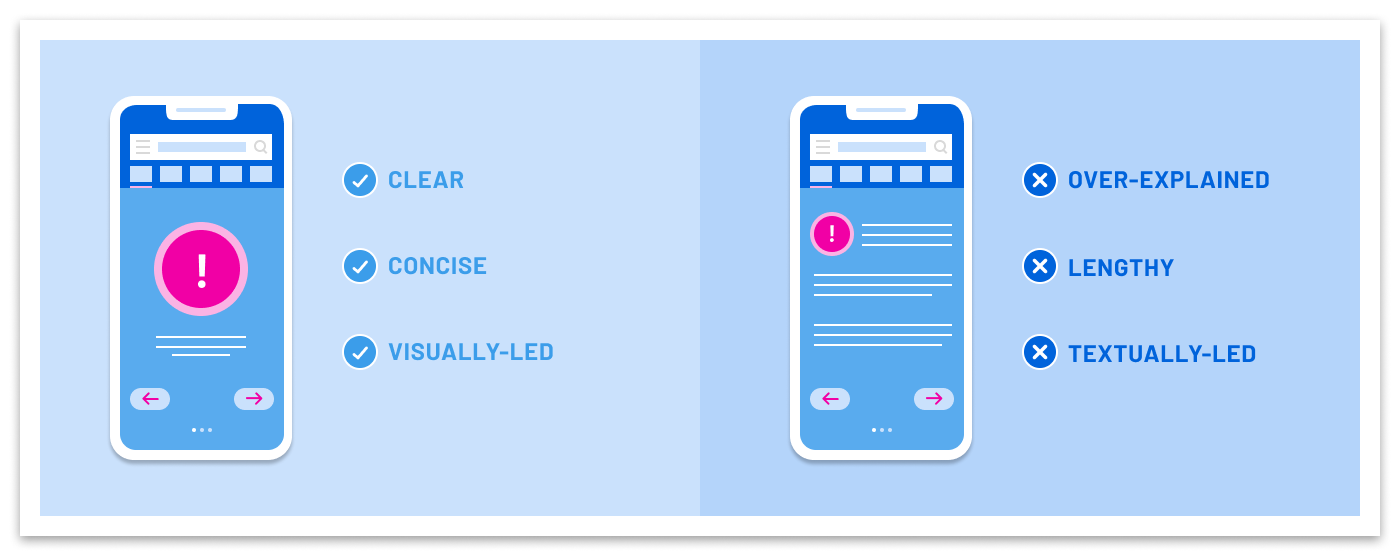Part of making your EdTech product truly accessible is inclusive design; the other necessary part is inclusive copywriting. Both elements, when working in harmony, help create meaningful learning experiences.
However, it’s important to recognize that product design processes may create dissonance between these two elements. Too frequently, copywriting is treated as an afterthought. And that may end up causing accessibility issues that get caught late in the game. Or not at all.
As your product’s guiding voice, copy can make or break communication between users and your product. Functional copywriting alone isn’t enough. You need copywriting infused with inclusive language in order to help all learners achieve their goals.
Copy Is Your EdTech Product’s “Voice”
No matter what the educational environment, learners need guides. When it comes to your EdTech product, copy is its guiding voice. Menus, buttons, security and error messages, terms and conditions, and instructions on individual pages and tasks: All of these product components must communicate with users effectively.
When your product’s copy is a good guide — an effective guide — it helps learners make decisions, answers their questions, and enables them to navigate interactions with minimal friction. But keep in mind that good copy is more than just functional. If your copy is merely functional, it’s unlikely users will build trust and confidence in your product. Here’s why:
“Functional” Copywriting Comes With Risk
Copywriting can’t just mean well. It must do well.
Yes, copy needs to be understandable to users so they can complete tasks. But copy is the voice of your product, and as such, it should strive for more. Copywriting is made up of words, and words have the potential to be powerful. They can tell attention-getting stories, provide critical context, and highlight ideas. Don’t you want to leverage those capabilities?
Your copywriting can end up flat and unengaging if it isn’t treated like the craft that it is. But poor copywriting can do more harm than bore users. It can cross the line into being:
- Dated. Just like design, copy should evolve.
- Unhelpful. Vague language quickly frustrates users.
- Off-putting. Copy that is stiff or formal may repel users.
- Biased. Even subtle phrasing can carry assumptions and bias.
- Triggering. Copy may unintentionally use words and ideas that emotionally trigger users.
Inclusive copywriting is laser-focused on what users need. It should demonstrate a deep understanding of who they are, how they read and learn, and what their goals and objectives are.
5 Essential Qualities of Inclusive Copywriting
Writing, editing, and iterating on your EdTech product’s copy to make it inclusive and build trust with users needn’t be a guessing game. Just make sure your copywriting has these 5 qualities.
1. Inclusive Copywriting Is Actionable
Actionable copy isn’t just informative; it drives users to take action. Actionable copy provides users with clear instructions that allow them to accomplish their tasks or goals very easily. You can create more actionable copy by:
- Starting with verbs. Users tend to focus on the first few words of a sentence, so cut to the chase with just the right verb (for example, “register,”“learn,” or “begin”).
- Aligning copy with what you want users to do. Determine what you want users to accomplish and choose precise language to support that (for example, “begin quiz”).
- Crafting surrounding copy that supports the desired action. Take opportunities to reinforce the action you want users to take (for example, ”select the correct answer”, “agree to terms and conditions”, or “add to favorites”).
2. Inclusive Copywriting Is Clear
Inclusive copywriting should be clear and easily understood by all users. It’s very helpful to avoid any type of jargon. You can also make copy clear by avoiding long, winding sentences. Use bullets, numbered lists, and headings and subheadings to “chunk” information. Visual cues can increase clarity, too.
Clear copywriting also considers:
- Appropriate reading level. Part of knowing your users is knowing what grade level to write in. Generally speaking, an eighth-grade reading level is good for all audiences as it’s less time-consuming to read. Flesch-Kincaid readability scores can help you ascertain if you’re hitting the mark.
- The needs of non-native English speakers. To serve non-native English speakers, write for a 6th-grade reading level on the Flesch-Kincaid readability scale. Keep fonts clean and simple, avoid colloquial language and be culturally sensitive.
3. Inclusive Copywriting Is Concise
Keep your copy short to help make it accessible to a wider audience. Use as few words as possible. Exact and concise are always better than meandering and ambiguous. This is especially true for your product’s microcopy — utilitarian copy that acts as wayfinding signage. Clarity and conciseness go hand in hand for microcopy; over-explaining rarely (if ever) helps users complete a task.
As EdTech products take more cues from continuing education and skills-based learning, brevity is paramount. In these settings, learners want to work toward their goals expeditiously. If one interaction is too overbearing and wordy, the entire learning experience can be jeopardized.

4. Inclusive Copywriting Is Specific
Your users cannot be described as “everyone.” You must know who your users are (and aren’t) and use the language that communicates best with them. UX research will reveal or confirm exactly who your users are, what their mental models are, and what their stresses and goals are.
Always bear in mind your Diversity, Equity, and Inclusion goals when writing copy. Your users are diverse in gender, sexual orientation, race, ethnicity, nationality, culture, disability, mental health, and education level. During testing cycles, you can ask for power users, casual users, and even non users’ feedback on your copy-related DEI efforts.
5. Inclusive Copywriting Is Consistent
If your language is inconsistent, users will be confused. If you have several people writing your product copy, it’s important that they make the same word choices, even for simple concepts. For example, if your copy reads “begin quiz” nine out of 10 times, “start quiz” is not an acceptable alternative for that 10th time.
Copy Serves as Your Connection to Users
In order to make sure your copywriting has all of these qualities, your team needs to work from a place of empathy. When you understand users’ points of view, thoughts, and feelings, plus the greater context of their lives, your copy will naturally become more inclusive. And when you prioritize inclusive copy and inclusive design, your product will surely be one users come back to again and again.
